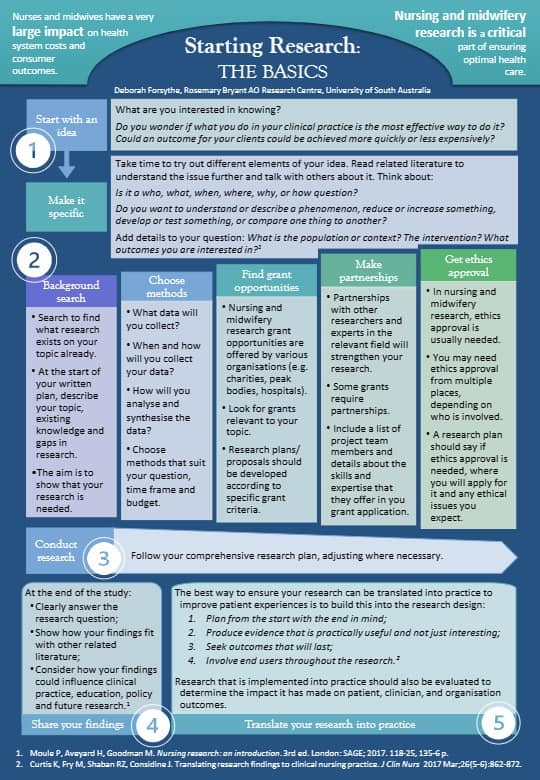Nursing and midwifery practice significantly impacts the health of Australians. This makes nursing and midwifery research critical.
The best people to conduct this research are nurses and midwives themselves, says Deborah Forsythe, an academic researcher in UniSA Clinical & Health Sciences with the Rosemary Bryant AO Research Centre.
Based on her discussion paper, titled ‘Nursing and midwifery research – where do I get started?’, Ms Forsythe recently developed another paper covering the basic steps involved in beginning research.
They involve:
Step 1: Develop a research question
Every research project starts with an idea. For example, you may wonder if you are doing things the best way, or if an outcome for your patients could be achieved quicker or cheaper. Consider if you are interested in describing something, reducing or increasing something, developing or testing something, or comparing one thing to another.1 Once you have an idea, look at what is already published to see if your question has already been answered or how it fits with what is already known.
Research questions need to be specific to ensure the research is achievable. Think about the problem you want to address: is it a who, what, when, where, why, or how question?1 Work out your base question, then add detail. What interventions and outcomes are you interested in? What is the population or context? There are infinite possible research questions, even for one problem, so read related literature, talk with others, and take time to try out different elements and ideas.1
Step 2: Develop a research plan
Once you have a research question, you can start designing your study. You may need to apply for a grant, and this involves submitting a research proposal. Even if you don’t need funding, having a comprehensive research plan is important.
Nursing and midwifery research grant opportunities are offered by various organisations. Your topic may influence where you look, as funders (e.g. charities, peak bodies, universities) often have specific research interest areas. The dates and expectations of each grant opportunity are unique, so write each research proposal to meet the specific criteria.
Start your research plan with a background section describing your topic and discussing the existing evidence and gaps. The purpose here is to show the need for your research.1 Then describe the methods you plan to use. Your choices should be directed by your research question. Some questions, like those about the effectiveness of interventions, will likely lead to quantitative research methods.

For others, like those focused on understanding people’s experiences, qualitative methods are probably more suitable. You can also mix quantitative and qualitative methods, to look at both subjective components and measurable numerical data.2
Choosing your methods involves selecting a study type (eg. experimental study, cohort study, qualitative study), but also outlining the specific methods within it, such as when and how you plan to collect data (e.g. surveys, medical records, interviews), and how you will analyse and synthesise data. Make choices that work with your question, timeframe and budget.
Next, think about your team and list each person’s skills and expertise. In grant applications, this information assures funders that the team has the skills to finish the research successfully. Some grants also require partnerships between researchers from different institutions or fields. Forming partnerships with other researchers and experts in the field will strengthen your research.
In nursing and midwifery research, ethics approval is usually required. You may even need to get approval from multiple places, depending on who is involved in the research. In your research plan, state where you will apply for ethics approval and list any anticipated ethical issues. The time taken from ethics submission to approval varies – your plan should allow time awaiting this before beginning the study.
Step 3: Conduct the study, translate into practice and evaluate
Conduct the study by simply following your research plan, and adjusting where necessary. At the end of the study, you will interpret and share your results. Clearly answer the research question and consider how your findings could influence clinical practice, education, policy and future research.3
Ultimately, the purpose of research in nursing and midwifery is to improve health outcomes. So, the translation of your research into practice is a critical part of the research. When possible, build this into the research design using these key principles: 1) plan from the start with the end in mind, 2) produce evidence that is practically useful and not just interesting, 3) seek lasting outcomes, and 4) involve end users throughout your research.3
Finally, remember to evaluate the impact your research has had on patient, clinician, and organisation outcomes after it is implemented into practice.
References
-
Moule P, Aveyard H, Goodman M. Nursing research: an introduction. 3rd ed. London: SAGE; 2017.
-
LoBiondo-Wood G, Haber J. Integrating research, evidence-based practice, and quality improvement processes. In: LoBiondo-Wood G, Haber J, editors. Nursing research: methods and critical appraisal for evidence-based practice. 8th ed. St. Louis:Mosby; 2014: 5-24.
-
Curtis K, Fry M, Shaban RZ, Considine J. Translating research findings to clinical nursing practice. J Clin Nurs. 2017;26(5-6):862-872. doi:10.1111/jocn.13586
Author
Deborah Forsythe, Researcher in UniSA Clinical & Health Sciences with the Rosemary Bryant AO Research Centre, Adelaide, South Australia








